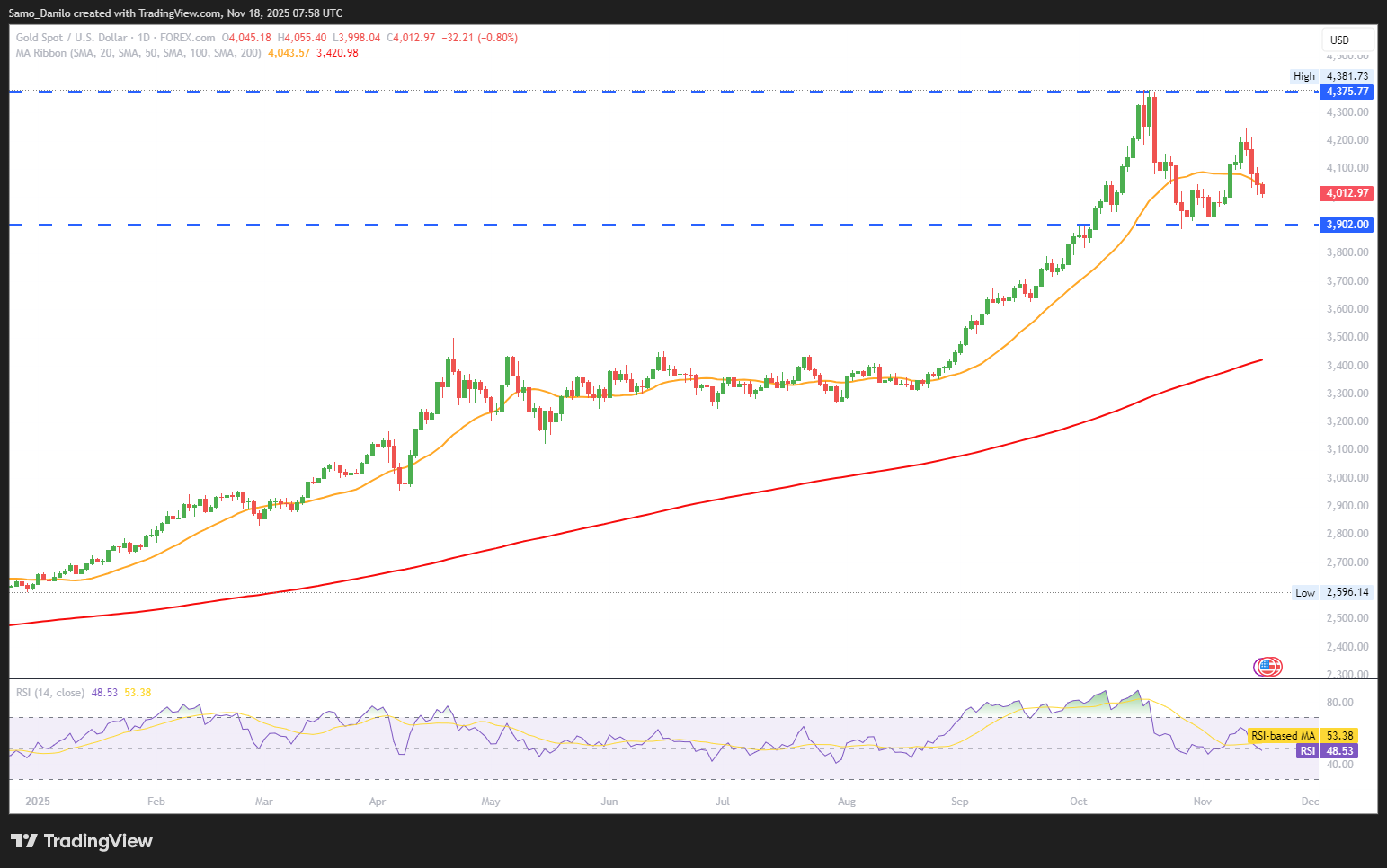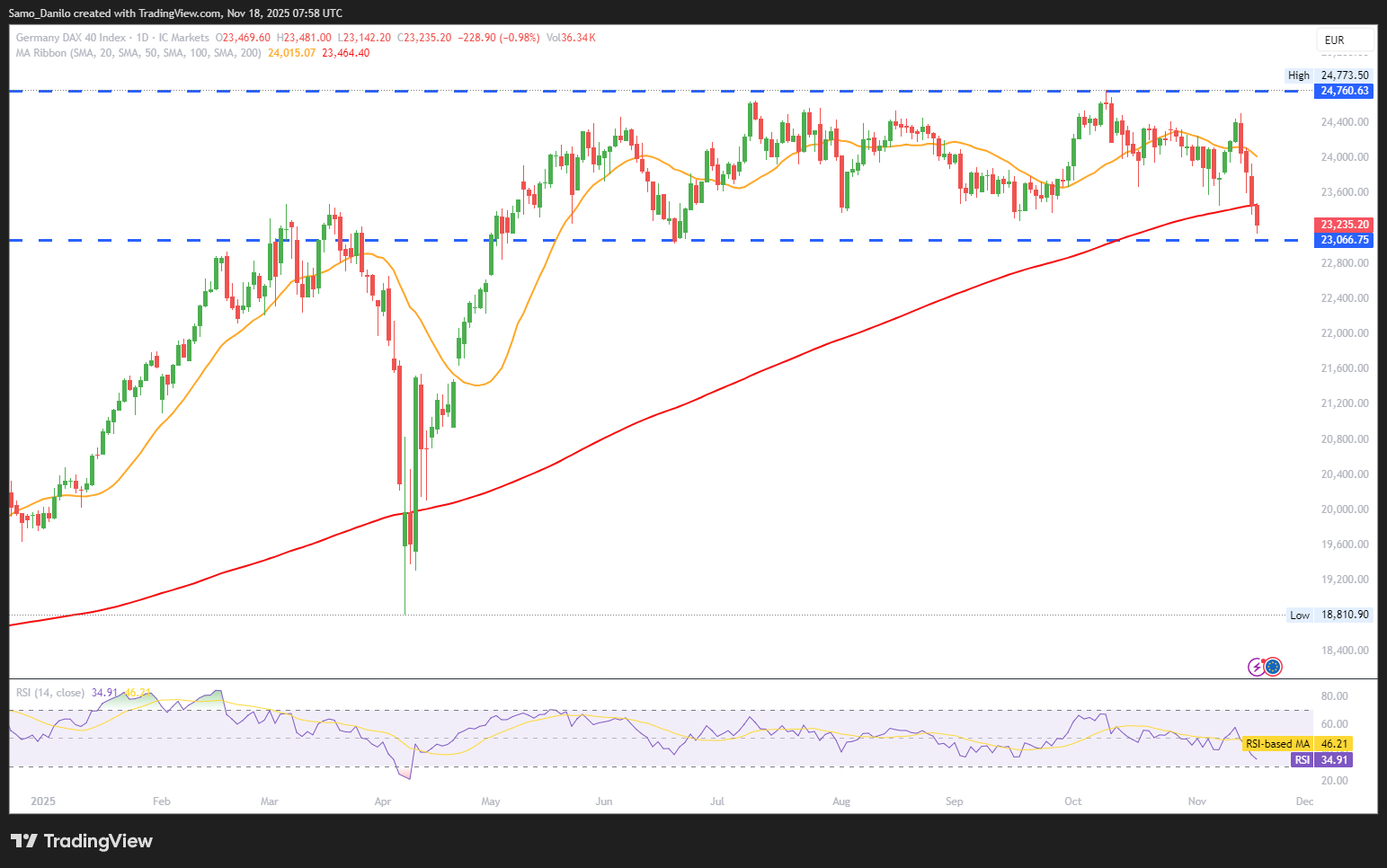EURUSD
- EUR/USD Price: EUR/USD is trading calmly around 1.1600 on Tuesday after retreating from a two-week high of 1.1656. The consolidation reflects a balanced market tone with no strong catalysts driving immediate direction.
- ECB Policy: The European Central Bank has kept interest rates unchanged since June 2025, and markets anticipate this pause will extend into next year. This stable policy stance limits volatility but also keeps the euro’s upside contained.
- ECB Officials: Most ECB policymakers continue to argue that rates should remain at current levels, given that risks to inflation and growth are broadly balanced. Their cautious messaging reinforces expectations of prolonged policy stability.
- Growth Forecasts: The European Commission downgraded its 2026 eurozone growth forecast to 1.2%, citing weakening export prospects amid US tariff impacts. This softer outlook may weigh modestly on euro sentiment over the medium term.
- Inflation Expectations: Headline inflation is projected to remain close to the ECB’s 2% goal across the forecast horizon, though underlying components show mixed trends. This supports the case for holding rates steady and reduces pressure for near-term monetary shifts.
Closing statement: EUR/USD remains in a consolidation phase as steady ECB policy and softer EU growth projections shape expectations. With inflation near target and limited catalysts ahead, the pair may continue to drift within a narrow range unless US data or policy rhetoric shifts the balance.
GBPUSD
- GBP/USD Price: GBP/USD remains under pressure for the third consecutive session, trading around 1.3150 on Tuesday. The muted price action reflects market caution ahead of key UK fiscal and inflation updates.
- Rate-Cut Expectations: Markets continue to favor a BoE rate cut in December, though policymakers stress that the decision hinges on incoming data. The Autumn Budget and next CPI print will be pivotal in shaping the Bank’s near-term policy trajectory.
- Fiscal Outlook: Chancellor Rachel Reeves scrapped planned income-tax increases, a move that has stirred concerns about fiscal sustainability. Despite this, the OBR revised the deficit outlook lower, to £20B from £35B, providing some relief but not eliminating long-term uncertainties.
- Fed Signals: Fed Governor Christopher Waller indicated the Fed should cut rates in December, adding downward pressure on the dollar. This supportive backdrop for GBP is somewhat offset by broader risk sentiment and domestic UK uncertainties.
- US Employment: The latest ADP Weekly Employment report continues to show softening labor conditions, with private payrolls at -11k per week over the four weeks to October 25. The trend signals cooling US economic momentum, potentially limiting USD strength.
Closing statement: GBP/USD remains range-bound with a slight bearish tilt as traders weigh UK fiscal developments against rising expectations for US rate cuts. Upcoming UK CPI data and the Autumn Budget will likely set the tone for the next decisive move in the pair.
XAUUSD
- XAU/USD Price: XAU/USD faces sustained selling pressure for a fourth consecutive session as traders scale back expectations for a December Fed rate cut. Bears are watching for a clean break below the $4,000 level, which could open the door to deeper declines.
- Fed’s Jefferson: Fed Vice Chair Philip Jefferson noted that upside inflation risks have eased and confirmed policy is now “somewhat restrictive.” However, he emphasized the need for a slow and careful approach as rates move closer to neutral—comments that dampened aggressive easing bets.
- US Government Shutdown: Despite the end of the government shutdown, markets remain uneasy about its lingering economic damage, limiting support for the US Dollar and preventing a stronger rebound in yields—factors that typically weigh on gold.
- Macro Data: With the government reopened, attention turns to the backlog of economic releases, particularly Thursday’s Nonfarm Payrolls report. Traders expect heightened volatility as the market digests data that has been withheld for weeks.
- Nvidia Earnings: Market sentiment is also sensitive to broader risk events. Nvidia’s Q3 earnings, expected to show ~$54B in revenue and a 73.3% gross margin, could influence overall risk appetite and spill over into gold markets depending on equity reactions.
Closing statement: Gold remains under pressure as easing expectations fade and markets brace for major US data releases. A break below $4,000 could accelerate bearish momentum, with macro fundamentals and cross-asset sentiment driving the next move.
CRUDE OIL
- Crude Oil Price: West Texas Intermediate continues to edge lower early Tuesday, trading around $59.30 per barrel after slipping from Monday’s close of $59.71. The persistent softness reflects renewed market concerns about a widening supply-demand imbalance.
- Oil Forecasts: Oil sentiment weakened after ING projected a significant market surplus through 2026, while Goldman Sachs warned that expanding production could maintain a ~2 million bpd surplus for the next two years. These forecasts reinforce a structurally bearish outlook for crude.
- OPEC+ Output: The broader narrative remains negative as both OPEC and non-OPEC nations continue to lift supply. OPEC+ approved another 137,000 bpd increase to its December target—matching October and November’s increments, before pausing further hikes in Q1 2025. The sustained ramp-up overshadows slowing global demand growth.
- Russian Energy: Some near-term relief may come from US sanctions on Rosneft and Lukoil, set to take effect on November 21. Major importers like China, India, and Turkey have already halted purchases in anticipation, potentially tightening available supply in the short run.
- Geopolitical Risks: Rising geopolitical tensions remain on the radar after Russia claimed new territorial gains in Orestopol and a Russian strike prompted the evacuation of a Romanian border village. While not yet driving markets, such instability could add a layer of risk-premium if escalations continue.
Closing statement: WTI remains pressured by a dominant oversupply narrative, reinforced by major institutional forecasts and increased OPEC+ output. Sanctions and geopolitical risks may offer pockets of support, but the medium-term bias stays firmly bearish unless supply conditions tighten.
DAX
- DAX Price: Investor caution dominated Tuesday’s session, pushing the DAX down to around 23,264 points, its weakest reading in five months. Risk appetite remains fragile as markets reassess Eurozone growth and geopolitical uncertainties.
- 2026 Outlook: The German Council of Economic Experts sharply cut its 2026 forecast, projecting only modest growth despite Chancellor Merz’s efforts to stimulate the economy. The downgrade reflects structural challenges, weak investment, and persistently soft industrial activity.
- Eurozone Growth: The EU now expects the economy to stagnate in 2025 following two years of contraction, with a rebound to 1.2% GDP growth in both 2026 and 2027. Higher public spending should provide support, but this is partially offset by rising trade tensions and weaker export prospects, key risks for Germany’s export-heavy economy.
- Defense Union: Chancellor Friedrich Merz is advocating for the EU to evolve into a European Defense Union, emphasizing Europe’s need to assume greater security responsibility. The proposal adds a geopolitical dimension to market sentiment as defense-related spending and strategic autonomy debates intensify.
- Germany–China: After high-level meetings in Beijing, Germany and China called for enhanced macroeconomic cooperation. However, Germany’s unease over Chinese industrial overcapacity—particularly in steel, solar, and EV production—was subtly but clearly reflected, hinting at potential future trade frictions.
Closing statement: The DAX is under pressure as markets weigh downgraded growth forecasts, geopolitical ambitions, and simmering EU–China trade concerns. While public spending and structural initiatives may support sentiment later in the year, the near-term outlook remains cautious with downside risks intact.




